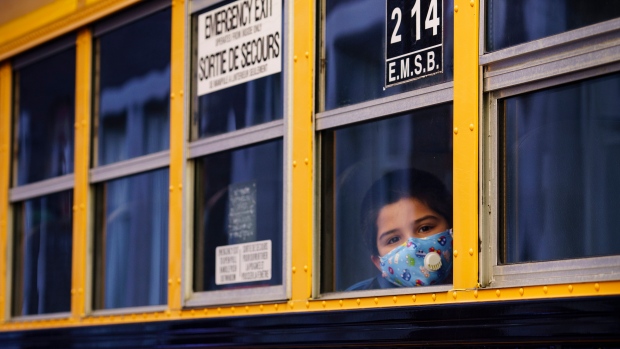
Schools shuttered by fears of a post-holiday pandemic surge reopen in many parts of the country Monday, but experts say keeping kids safe will depend on stepped-up control measures beyond the learning environment.
Thousands of students in Alberta, Quebec, Nova Scotia and Saskatchewan are among those set to reunite after an extended break, depending on their region and age group.
In some regions, the return to class coincides with tighter precautions both in and out of the classroom.
Grade 1 and 2 students in Quebec will join older elementary students in having to wear masks on school buses and in common areas, while those in Grades 5 and 6 will have to wear masks in class, too.
The biggest news in Quebec has been the introduction of Canada’s first COVID-19 curfew, which prevents most residents from leaving home between 8 p.m. and 5 a.m.
It’s a significant clampdown that should help shield schools from rising community rates that have pushed cases, hospitalizations and deaths to worrisome highs, observers say.
“We have to start talking about other sacrifices that we as communities are willing to make if we want our children to return to school,” says Ashleigh Tuite, an assistant professor at the University of Toronto’s Dalla Lana School of Public Health.
“I don’t love the idea of curfews or restricting movement but again, those are the sorts of measures that I think as adults we should be willing to take on if that means that will help reduce community transmission.”
Ontario was set to reopen elementary schools in the southern half of the province on Monday, but delayed that plan by two weeks due to staggering case counts and a worrisome rise in positivity rates among children.
Ontario’s chief medical officer of health said last week the positivity rate among tested children approached 20 per cent in early January for 12-13 year-olds, up sharply from 5 per cent in late November and early December.
A survey of provincial COVID-19 test results broken down by age also revealed lesser but still significant spikes for other age groups, including a jump to 16 per cent from 5 per cent for 4 to 11-year-olds, and a rise to 14 per cent from 6 per cent for 14 to 17-year-olds.
That’s in tandem with soaring infections that set a daily record of more than 4,200 reported cases Friday, although that included a backlog of about 450 cases.
Ontario has suggested further restrictions are on the way, and expressed a vague desire to introduce more school-based measures aimed at suppressing transmission rates, but no details have been released.
Coming up with the right balance of community-based and school-based restrictions is an imprecise science, says University of Manitoba virologist Jason Kindrachuk, but he says any steps to rein in broader infections help prevent the chance of outbreaks in class.
“We probably shouldn’t be talking about school closures if we’re not also talking about closures of all non-essential businesses and as well, offices,” Kindrachuk says from Saskatoon, where he’s working with the University of Saskatchewan’s Vaccine and Infectious Disease Organization-International Vaccine Centre.
But also key is better data to assess just how susceptible school children really are, he said, repeating calls for asymptomatic testing: “We don’t fully understand still to this day what transmission looks like in schools.”
Provincial lockdown measures have been extended in Alberta and Manitoba, while Saskatchewan has said it plans to review the status of its Christmas limits on gatherings and retail capacity.
Kids in British Columbia returned to public school after a two-week winter break last week, but there’s pressure there, too, to ramp up protections including mask mandates and physical distancing.
Teachers in the Fraser Health region are especially concerned about “schools where health and safety standards are inadequate, inconsistent, or unsafe,” the B.C. Teachers’ Federation said Friday in a release.
The federation is calling on provincial authorities to reduce density in schools, improve ventilation, make masks mandatory in all indoor spaces and ensure educators and school staff “are appropriately prioritized” for COVID-19 vaccinations.
Kindrachuk says the arrival of a more infectious COVID-19 variant from the U.K. further raises the stakes for infection control.
“Things don’t go from one day being kind of fine to all of a sudden being bad the next day,” he said. “There’s a slow escalation and then everything starts to hit that exponential phase where you’re not going up linearly, now you’re actually going up very, very precipitously.”































